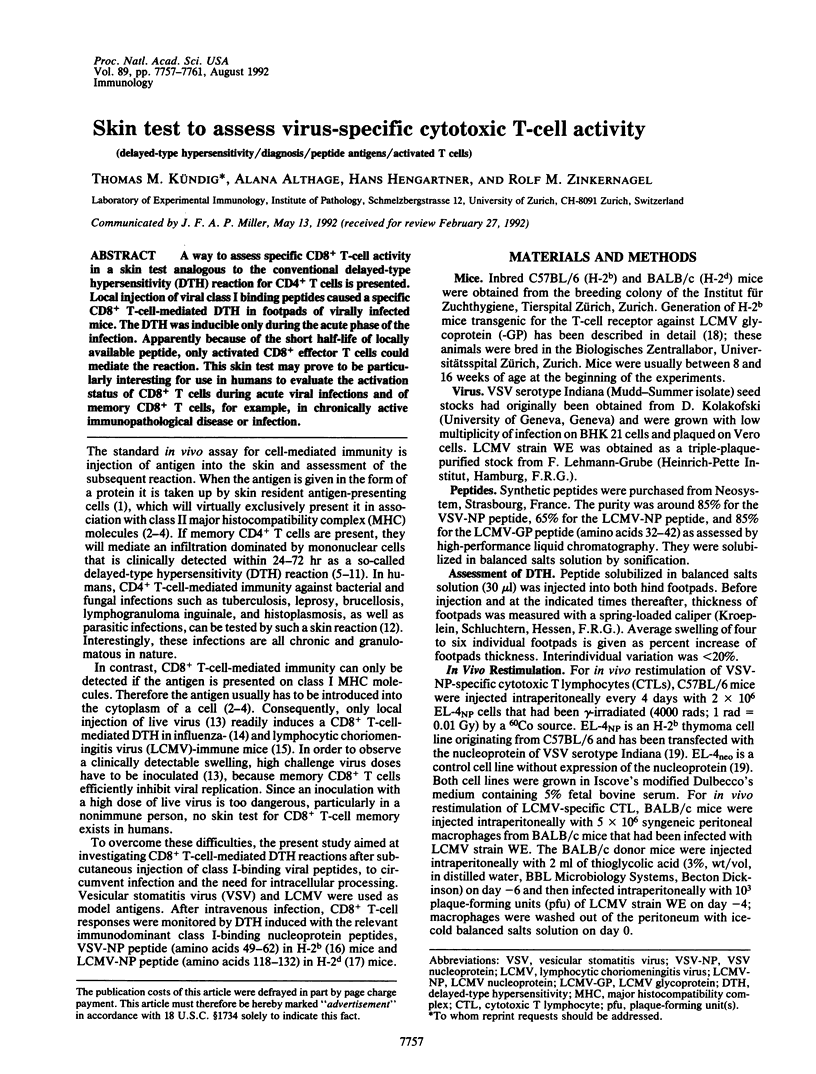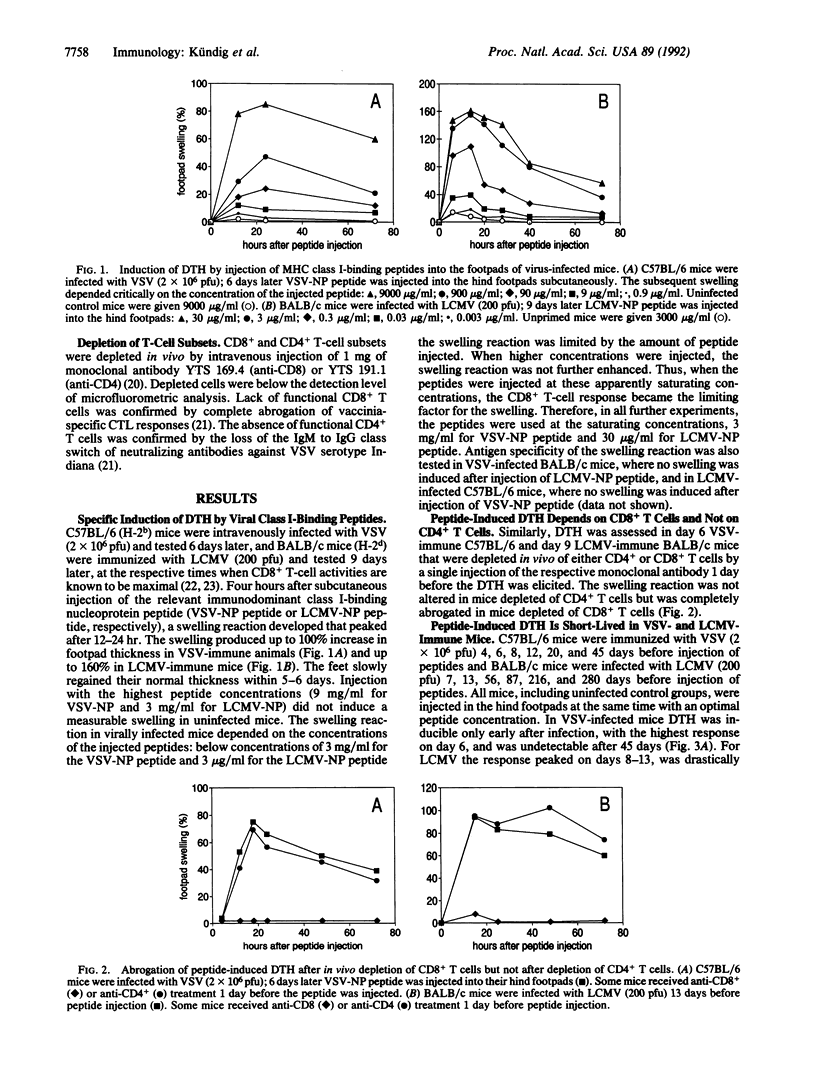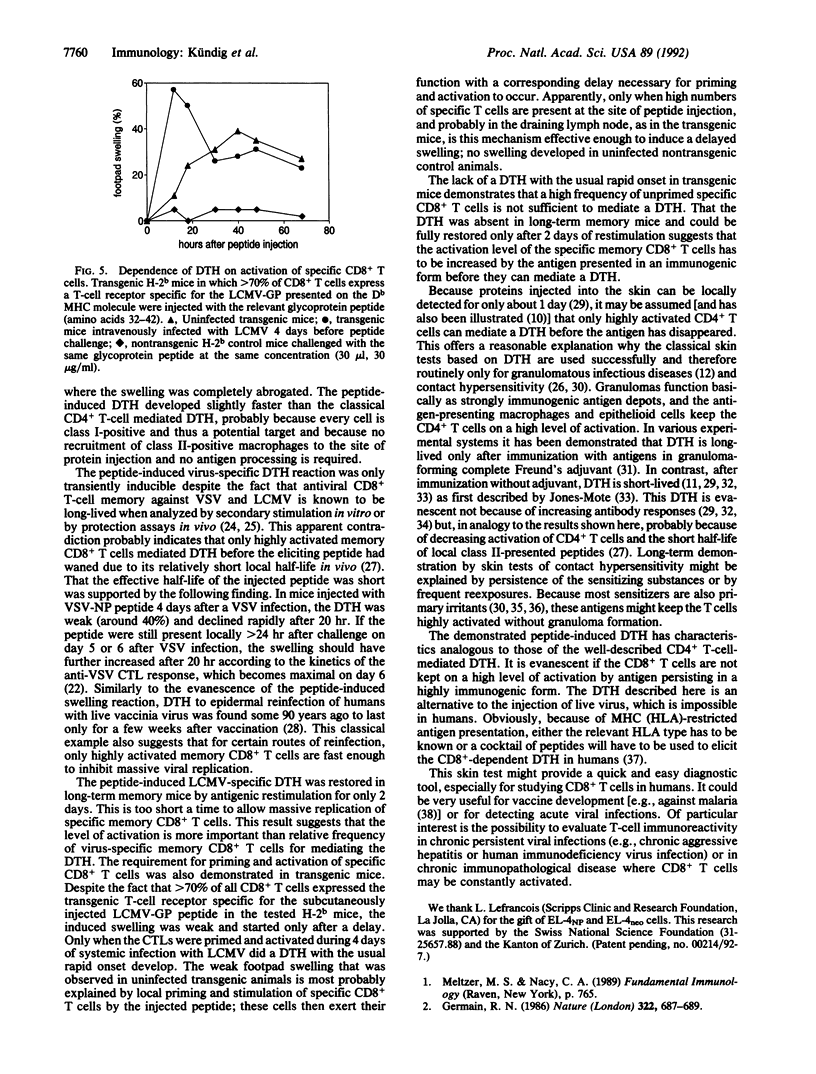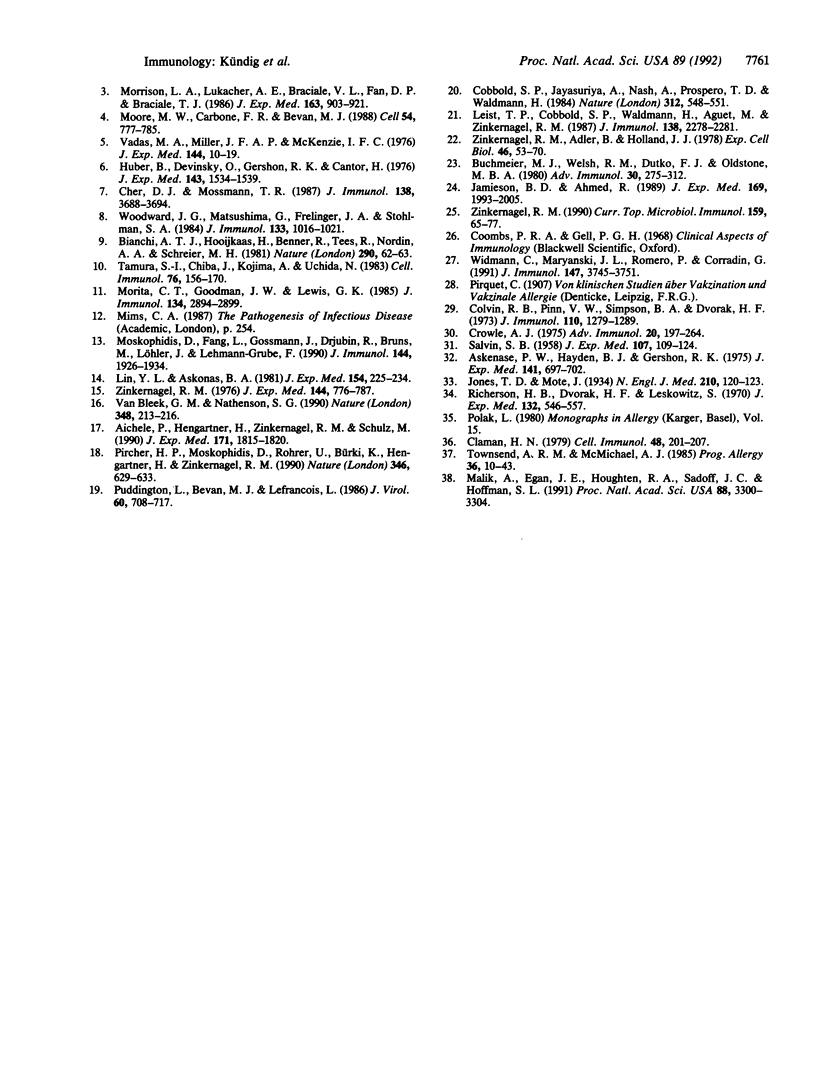Abstract
A way to assess specific CD8+ T-cell activity in a skin test analogous to the conventional delayed-type hypersensitivity (DTH) reaction for CD4+ T cells is presented. Local injection of viral class I binding peptides caused a specific CD8+ T-cell-mediated DTH in footpads of virally infected mice. The DTH was inducible only during the acute phase of the infection. Apparently because of the short half-life of locally available peptide, only activated CD8+ effector T cells could mediate the reaction. This skin test may prove to be particularly interesting for use in humans to evaluate the activation status of CD8+ T cells during acute viral infections and of memory CD8+ T cells, for example, in chronically active immunopathological disease or infection.
Full text
PDF




Selected References
These references are in PubMed. This may not be the complete list of references from this article.
- Aichele P., Hengartner H., Zinkernagel R. M., Schulz M. Antiviral cytotoxic T cell response induced by in vivo priming with a free synthetic peptide. J Exp Med. 1990 May 1;171(5):1815–1820. doi: 10.1084/jem.171.5.1815. [DOI] [PMC free article] [PubMed] [Google Scholar]
- Askenase P. W., Hayden B. J., Gershon R. K. Augmentation of delayed-type hypersensitivity by doses of cyclophosphamide which do not affect antibody responses. J Exp Med. 1975 Mar 1;141(3):697–702. doi: 10.1084/jem.141.3.697. [DOI] [PMC free article] [PubMed] [Google Scholar]
- Bianchi A. T., Hooijkaas H., Benner R., Tees R., Nordin A. A., Schreier M. H. Clones of helper T cells mediate antigen-specific, H-2-restricted DTH. Nature. 1981 Mar 5;290(5801):62–63. doi: 10.1038/290062a0. [DOI] [PubMed] [Google Scholar]
- Buchmeier M. J., Welsh R. M., Dutko F. J., Oldstone M. B. The virology and immunobiology of lymphocytic choriomeningitis virus infection. Adv Immunol. 1980;30:275–331. doi: 10.1016/s0065-2776(08)60197-2. [DOI] [PubMed] [Google Scholar]
- Cher D. J., Mosmann T. R. Two types of murine helper T cell clone. II. Delayed-type hypersensitivity is mediated by TH1 clones. J Immunol. 1987 Jun 1;138(11):3688–3694. [PubMed] [Google Scholar]
- Claman H. N. Hypothesis. T-cell tolerance--one signal? Cell Immunol. 1979 Nov;48(1):201–207. doi: 10.1016/0008-8749(79)90112-6. [DOI] [PubMed] [Google Scholar]
- Cobbold S. P., Jayasuriya A., Nash A., Prospero T. D., Waldmann H. Therapy with monoclonal antibodies by elimination of T-cell subsets in vivo. Nature. 1984 Dec 6;312(5994):548–551. doi: 10.1038/312548a0. [DOI] [PubMed] [Google Scholar]
- Colvin R. B., Pinn V. W., Simpson B. A., Dvorak H. F. Cutaneous basophil hypersensitivity. IV. The "late reaction": sequel to Jones-Mote type hypersensitivity. Comparison with rabbit Arthus reaction. Effect of passive antibody on induction and expression of Jones-Mote hypersensitivity. J Immunol. 1973 May;110(5):1279–1289. [PubMed] [Google Scholar]
- Crowle A. J. Delayed hypersensitivity in the mouse. Adv Immunol. 1975;20:197–264. doi: 10.1016/s0065-2776(08)60209-6. [DOI] [PubMed] [Google Scholar]
- Germain R. N. Immunology. The ins and outs of antigen processing and presentation. Nature. 1986 Aug 21;322(6081):687–689. doi: 10.1038/322687a0. [DOI] [PubMed] [Google Scholar]
- Huber B., Devinsky O., Gershon R. K., Cantor H. Cell-mediated immunity: delayed-type hypersensitivity and cytotoxic responses are mediated by different T-cell subclasses. J Exp Med. 1976 Jun 1;143(6):1534–1539. doi: 10.1084/jem.143.6.1534. [DOI] [PMC free article] [PubMed] [Google Scholar]
- Jamieson B. D., Ahmed R. T cell memory. Long-term persistence of virus-specific cytotoxic T cells. J Exp Med. 1989 Jun 1;169(6):1993–2005. doi: 10.1084/jem.169.6.1993. [DOI] [PMC free article] [PubMed] [Google Scholar]
- Leist T. P., Cobbold S. P., Waldmann H., Aguet M., Zinkernagel R. M. Functional analysis of T lymphocyte subsets in antiviral host defense. J Immunol. 1987 Apr 1;138(7):2278–2281. [PubMed] [Google Scholar]
- Lin Y. L., Askonas B. A. Biological properties of an influenza A virus-specific killer T cell clone. Inhibition of virus replication in vivo and induction of delayed-type hypersensitivity reactions. J Exp Med. 1981 Aug 1;154(2):225–234. doi: 10.1084/jem.154.2.225. [DOI] [PMC free article] [PubMed] [Google Scholar]
- Malik A., Egan J. E., Houghten R. A., Sadoff J. C., Hoffman S. L. Human cytotoxic T lymphocytes against the Plasmodium falciparum circumsporozoite protein. Proc Natl Acad Sci U S A. 1991 Apr 15;88(8):3300–3304. doi: 10.1073/pnas.88.8.3300. [DOI] [PMC free article] [PubMed] [Google Scholar]
- Moore M. W., Carbone F. R., Bevan M. J. Introduction of soluble protein into the class I pathway of antigen processing and presentation. Cell. 1988 Sep 9;54(6):777–785. doi: 10.1016/s0092-8674(88)91043-4. [DOI] [PubMed] [Google Scholar]
- Morita C. T., Goodman J. W., Lewis G. K. Arsonate-specific murine T cell clones. II. Delayed-type hypersensitivity induced by P-azobenzenearsonate-L-tyrosine (ABA-Tyr). J Immunol. 1985 May;134(5):2894–2899. [PubMed] [Google Scholar]
- Morrison L. A., Lukacher A. E., Braciale V. L., Fan D. P., Braciale T. J. Differences in antigen presentation to MHC class I-and class II-restricted influenza virus-specific cytolytic T lymphocyte clones. J Exp Med. 1986 Apr 1;163(4):903–921. doi: 10.1084/jem.163.4.903. [DOI] [PMC free article] [PubMed] [Google Scholar]
- Moskophidis D., Fang L., Gossmann J., Drjupin R., Löhler J., Bruns M., Lehmann-Grube F. Virus-specific delayed-type hypersensitivity (DTH). Cells mediating lymphocytic choriomeningitis virus-specific DTH reaction in mice. J Immunol. 1990 Mar 1;144(5):1926–1934. [PubMed] [Google Scholar]
- Pircher H., Moskophidis D., Rohrer U., Bürki K., Hengartner H., Zinkernagel R. M. Viral escape by selection of cytotoxic T cell-resistant virus variants in vivo. Nature. 1990 Aug 16;346(6285):629–633. doi: 10.1038/346629a0. [DOI] [PubMed] [Google Scholar]
- Puddington L., Bevan M. J., Rose J. K., Lefrançois L. N protein is the predominant antigen recognized by vesicular stomatitis virus-specific cytotoxic T cells. J Virol. 1986 Nov;60(2):708–717. doi: 10.1128/jvi.60.2.708-717.1986. [DOI] [PMC free article] [PubMed] [Google Scholar]
- Richerson H. B., Dvorak H. F., Leskowitz S. Cutaneous basophil hypersensitivity. I. A new look at the Jones-Mote reaction, general characteristics. J Exp Med. 1970 Sep 1;132(3):546–557. doi: 10.1084/jem.132.3.546. [DOI] [PMC free article] [PubMed] [Google Scholar]
- SALVIN S. B. Occurrence of delayed hypersensitivity during the development of Arthus type hypersensitivity. J Exp Med. 1958 Jan 1;107(1):109–124. doi: 10.1084/jem.107.1.109. [DOI] [PMC free article] [PubMed] [Google Scholar]
- Tamura S. I., Chiba J., Kojima A., Uchida N. Properties of cloned T cells that mediate delayed-type hypersensitivity against ovalbumin in mice. Cell Immunol. 1983 Feb 15;76(1):156–170. doi: 10.1016/0008-8749(83)90358-1. [DOI] [PubMed] [Google Scholar]
- Townsend A. R., McMichael A. J. Specificity of cytotoxic T lymphocytes stimulated with influenza virus. Studies in mice and humans. Prog Allergy. 1985;36:10–43. doi: 10.1159/000409860. [DOI] [PubMed] [Google Scholar]
- Vadas M. A., Miller J. F., McKenzie I. F., Chism S. E., Shen F. W., Boyse E. A., Gamble J. R., Whitelaw A. M. Ly and Ia antigen phenotypes of T cells involved in delayed-type hypersensitivity and in suppression. J Exp Med. 1976 Jul 1;144(1):10–19. doi: 10.1084/jem.144.1.10. [DOI] [PMC free article] [PubMed] [Google Scholar]
- Van Bleek G. M., Nathenson S. G. Isolation of an endogenously processed immunodominant viral peptide from the class I H-2Kb molecule. Nature. 1990 Nov 15;348(6298):213–216. doi: 10.1038/348213a0. [DOI] [PubMed] [Google Scholar]
- Widmann C., Maryanski J. L., Romero P., Corradin G. Differential stability of antigenic MHC class I-restricted synthetic peptides. J Immunol. 1991 Dec 1;147(11):3745–3751. [PubMed] [Google Scholar]
- Woodward J. G., Matsushima G., Frelinger J. A., Stohlman S. A. Production and characterization of T cell clones specific for mouse hepatitis virus, strain JHM: in vivo and in vitro analysis. J Immunol. 1984 Aug;133(2):1016–1021. [PubMed] [Google Scholar]
- Zinkernagel R. M., Adler B., Holland J. J. Cell-mediated immunity to vesicular stomatitis virus infections in mice. Exp Cell Biol. 1978;46(1-2):53–70. doi: 10.1159/000162882. [DOI] [PubMed] [Google Scholar]
- Zinkernagel R. M. Antiviral T-cell memory? Curr Top Microbiol Immunol. 1990;159:65–77. doi: 10.1007/978-3-642-75244-5_4. [DOI] [PubMed] [Google Scholar]
- Zinkernagel R. M. H-2 restriction of virus-specific T-cell-mediated effector functions in vivo. II. Adoptive transfer of delayed-type hypersensitivity to murine lymphocytic choriomeningits virus is restriced by the K and D region of H-2. J Exp Med. 1976 Sep 1;144(3):776–787. doi: 10.1084/jem.144.3.776. [DOI] [PMC free article] [PubMed] [Google Scholar]


